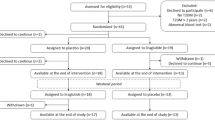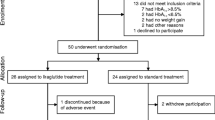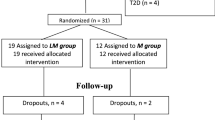Abstract
Aims/hypothesis
Liraglutide can modulate insulin secretion by directly stimulating beta cells or indirectly through weight loss and enhanced insulin sensitivity. Recently, we showed that liraglutide treatment in overweight individuals with prediabetes (impaired fasting glucose and/or impaired glucose tolerance) led to greater weight loss (−7.7% vs −3.9%) and improvement in insulin resistance compared with placebo. The current study evaluates the effects on beta cell function of weight loss augmented by liraglutide compared with weight loss alone.
Methods
This was a parallel, randomised study conducted in a single academic centre. Both participants and study administrators were blinded to treatment assignment. Individuals who were 40–70 years old, overweight (BMI 27–40 kg/m2) and with prediabetes were randomised (via a computerised system) to receive liraglutide (n = 35) or matching placebo (n = 33), and 49 participants were analysed. All were instructed to follow an energy-restricted diet. Primary outcome was insulin secretory function, which was evaluated in response to graded infusions of glucose and day-long mixed meals.
Results
Liraglutide treatment (n = 24) significantly (p ≤ 0.03) increased the insulin secretion rate (% mean change [95% CI]; 21% [12, 31] vs −4% [−11, 3]) and pancreatic beta cell sensitivity to intravenous glucose (229% [161, 276] vs −0.5% (−15, 14]), and decreased insulin clearance rate (−3.5% [−11, 4] vs 8.2 [0.2, 16]) as compared with placebo (n = 25). The liraglutide-treated group also had significantly (p ≤ 0.03) lower day-long glucose (−8.2% [−11, −6] vs −0.1 [−3, 2]) and NEFA concentrations (−14 [−20, −8] vs −2.1 [−10, 6]) following mixed meals, whereas day-long insulin concentrations did not significantly differ as compared with placebo. In a multivariate regression analysis, weight loss was associated with a decrease in insulin secretion rate and day-long glucose and insulin concentrations in the placebo group (p ≤ 0.05), but there was no association with weight loss in the liraglutide group. The most common side effect of liraglutide was nausea.
Conclusions/interpretation
A direct stimulatory effect on beta cell function was the predominant change in liraglutide-augmented weight loss. These changes appear to be independent of weight loss.
Trial registration
ClinicalTrials.gov NCT01784965
Funding
The study was funded by the ADA.


Similar content being viewed by others
Abbreviations
- GGIT:
-
Graded-glucose infusion test
- GLP-1:
-
Glucagon-like peptide 1
- IFG:
-
Impaired fasting glucose
- IGT:
-
Impaired glucose tolerance
- MMTT:
-
Mixed-meal tolerance test
- SSPG:
-
Steady-state plasma glucose
References
Holst JJ, Deacon CF (2013) Is there a place for incretin therapies in obesity and prediabetes? Trends Endocrinol Metab 24:145–152
Knowler WC, Barrett-Connor E, Fowler SE et al (2002) Reduction in the incidence of type 2 diabetes with lifestyle intervention or metformin. N Engl J Med 346:393–403
Tuomilehto J, Lindstrom J, Eriksson JG et al (2001) Prevention of type 2 diabetes mellitus by changes in lifestyle among subjects with impaired glucose tolerance. N Engl J Med 344:1343–1350
Pan XR, Li GW, Hu YH et al (1997) Effects of diet and exercise in preventing NIDDM in people with impaired glucose tolerance. The Da Qing IGT and Diabetes Study. Diabetes Care 20:537–544
Saito T, Watanabe M, Nishida J et al (2011) Lifestyle modification and prevention of type 2 diabetes in overweight Japanese with impaired fasting glucose levels: a randomized controlled trial. Arch Intern Med 171:1352–1360
McLaughlin T, Carter S, Lamendola C et al (2006) Effects of moderate variations in macronutrient composition on weight loss and reduction in cardiovascular disease risk in obese, insulin-resistant adults. Am J Clin Nutr 84:813–821
Utzschneider KM, Carr DB, Barsness SM, Kahn SE, Schwartz RS (2004) Diet-induced weight loss is associated with an improvement in beta-cell function in older men. J Clin Endocrinol Metab 89:2704–2710
Hanley AJ, Zinman B, Sheridan P, Yusuf S, Gerstein HC, Investigators DRAWRaRMD (2010) Effect of Rosiglitazone and Ramipril on β-cell function in people with impaired glucose tolerance or impaired fasting glucose: the DREAM trial. Diabetes Care 33:608–613
Degn KB, Juhl CB, Sturis J et al (2004) One week’s treatment with the long-acting glucagon-like peptide 1 derivative liraglutide (NN2211) markedly improves 24-h glycemia and alpha- and beta-cell function and reduces endogenous glucose release in patients with type 2 diabetes. Diabetes 53:1187–1194
Mari A, Degn K, Brock B, Rungby J, Ferrannini E, Schmitz O (2007) Effects of the long-acting human glucagon-like peptide-1 analog liraglutide on beta-cell function in normal living conditions. Diabetes Care 30:2032–2033
Kim SH, Abbasi F, Lamendola C et al (2013) Benefits of liraglutide treatment in overweight and obese older individuals with prediabetes. Diabetes Care 36:3276–3282
Greenfield MS, Doberne L, Kraemer F, Tobey T, Reaven G (1981) Assessment of insulin resistance with the insulin suppression test and the euglycemic clamp. Diabetes 30:387–392
Kim SH, Abbasi F, Chu JW et al (2005) Rosiglitazone reduces glucose-stimulated insulin secretion rate and increases insulin clearance in nondiabetic, insulin-resistant individuals. Diabetes 54:2447–2452
Jones CN, Pei D, Staris P, Polonsky KS, Chen YD, Reaven GM (1997) Alterations in the glucose-stimulated insulin secretory dose-response curve and in insulin clearance in nondiabetic insulin-resistant individuals. J Clin Endocrinol Metab 82:1834–1838
Van Cauter E, Mestrez F, Sturis J, Polonsky KS (1992) Estimation of insulin secretion rates from C-peptide levels. Comparison of individual and standard kinetic parameters for C-peptide clearance. Diabetes 41:368–377
Astrup A, Rössner S, Van Gaal L et al (2009) Effects of liraglutide in the treatment of obesity: a randomised, double-blind, placebo-controlled study. Lancet 374:1606–1616
Rosenstock J, Klaff LJ, Schwartz S et al (2010) Effects of exenatide and lifestyle modification on body weight and glucose tolerance in obese subjects with and without pre-diabetes. Diabetes Care 33:1173–1175
Elkind-Hirsch K, Marrioneaux O, Bhushan M, Vernor D, Bhushan R (2008) Comparison of single and combined treatment with exenatide and metformin on menstrual cyclicity in overweight women with polycystic ovary syndrome. J Clin Endocrinol Metab 93:2670–2678
Nathan DM, Davidson MB, DeFronzo RA et al (2007) Impaired fasting glucose and impaired glucose tolerance: implications for care. Diabetes Care 30:753–759
American Diabetes Association (2013) Standards of medical care in diabetes–2013. Diabetes Care 36(Suppl 1):S11–S66
Kjems LL, Holst JJ, Vølund A, Madsbad S (2003) The influence of GLP-1 on glucose-stimulated insulin secretion: effects on beta-cell sensitivity in type 2 and nondiabetic subjects. Diabetes 52:380–386
Reaven G, Dray J (1967) Effect of chlorpropamide on serum glucose and immunoreactive insulin concentrations in patients with maturity-onset diabetes mellitus. Diabetes 16:487–492
Gumbiner B, Van Cauter E, Beltz WF et al (1996) Abnormalities of insulin pulsatility and glucose oscillations during meals in obese noninsulin-dependent diabetic patients: effects of weight reduction. J Clin Endocrinol Metab 81:2061–2068
Perreault L, Pan Q, Mather KJ et al (2012) Effect of regression from prediabetes to normal glucose regulation on long-term reduction in diabetes risk: results from the Diabetes Prevention Program Outcomes Study. Lancet 379:2243–2251
McLaughlin T, Abbasi F, Lamendola C, Kim HS, Reaven GM (2001) Metabolic changes following sibutramine-assisted weight loss in obese individuals: role of plasma free fatty acids in the insulin resistance of obesity. Metabolism 50:819–824
Abbasi F, Chen YD, Farin HM, Lamendola C, Reaven GM (2008) Comparison of three treatment approaches to decreasing cardiovascular disease risk in nondiabetic insulin-resistant dyslipidemic subjects. Am J Cardiol 102:64–69
Meier JJ, Gethmann A, Götze O et al (2006) Glucagon-like peptide 1 abolishes the postprandial rise in triglyceride concentrations and lowers levels of non-esterified fatty acids in humans. Diabetologia 49:452–458
Schwartz EA, Koska J, Mullin MP, Syoufi I, Schwenke DC, Reaven PD (2010) Exenatide suppresses postprandial elevations in lipids and lipoproteins in individuals with impaired glucose tolerance and recent onset type 2 diabetes mellitus. Atherosclerosis 212:217–222
Acknowledgements
The authors thank P. Schaaf, the research dietitian, and the staff and nurses in the Stanford Clinical and Translational Research centre for their invaluable assistance with the study.
Funding
The study was funded by the ADA (7-09-NOVO-15 to GR). Liraglutide and matching placebo were provided by Novo Nordisk. The ADA and Novo Nordisk were not involved in the design or conduct of the study, the collection, management, analysis and interpretation of the data or the preparation, review or approval of the manuscript.
Duality of interest
The authors declare that there is no duality of interest associated with this manuscript.
Contribution statement
SHK and GR conceptualised and designed the study and interpreted the analyses. SHK performed data analysis and drafted the manuscript. GR revised the manuscript for critical intellectual content. AL, DA, FA, CL, KG and VT helped acquire the data and edited the manuscript. All authors approved the final version of the manuscript. SHK is the guarantor of this work and, as such, had full access to all of the data in the study and takes responsibility for the integrity of the data and accuracy of the data analysis.
Author information
Authors and Affiliations
Corresponding author
Electronic supplementary material
Below is the link to the electronic supplementary material.
ESM Fig. 1
(PDF 7 kb)
ESM Fig. 2
(PDF 25 kb)
ESM Fig. 3
(PDF 91 kb)
ESM Table 1
(PDF 15 kb)
Rights and permissions
About this article
Cite this article
Kim, S.H., Liu, A., Ariel, D. et al. Pancreatic beta cell function following liraglutide-augmented weight loss in individuals with prediabetes: analysis of a randomised, placebo-controlled study. Diabetologia 57, 455–462 (2014). https://doi.org/10.1007/s00125-013-3134-3
Received:
Accepted:
Published:
Issue Date:
DOI: https://doi.org/10.1007/s00125-013-3134-3




